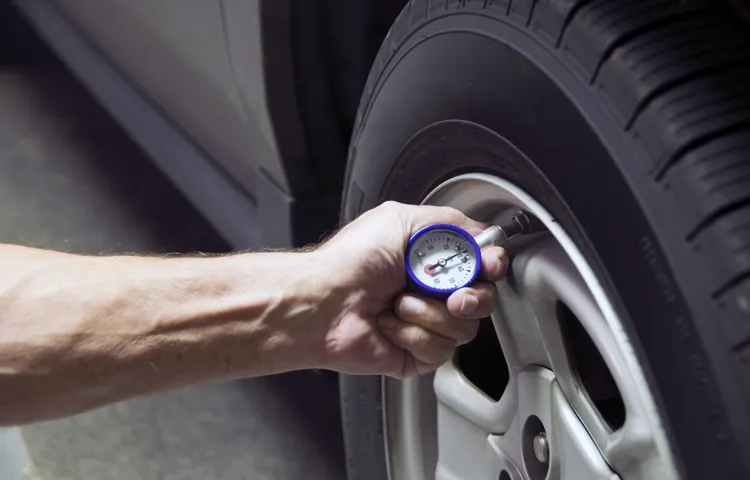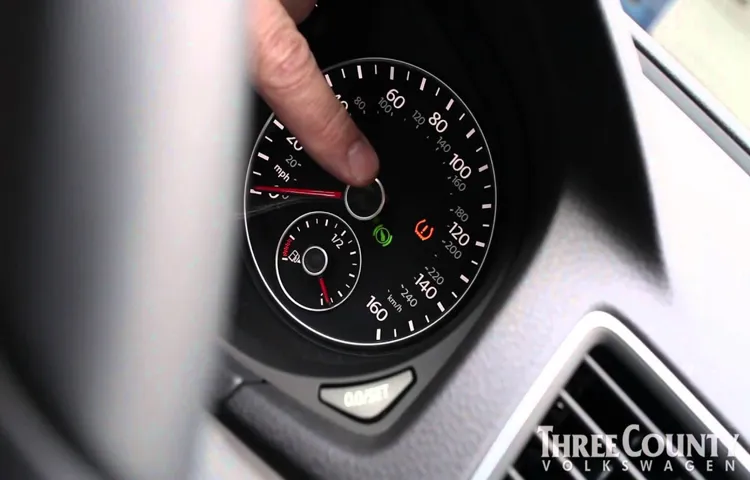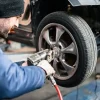As a Taos owner, one of the critical things you need to consider is ensuring your car’s tires are in good shape. While it might seem like a trivial matter, having the wrong tire pressure can impact your car’s performance and safety. Overinflated or underinflated tires can lead to poor gas mileage, decreased tire lifespan, and, in extreme cases, accidents.
Therefore, it is vital to understand how to check tire pressure on Volkswagen Taos 2022 and maintain your tires appropriately. In this blog post, we’ll explore some simple steps you can take to check your Taos’ tire pressure and keep your car running smoothly. So, let’s dive in!
Table of Contents
Why Checking Tire Pressure is Important
If you want to keep your Volkswagen Taos 2022 running smoothly and extend the lifespan of its tires, then it’s important to check the tire pressure regularly. But how do you do it? First and foremost, you need a tire pressure gauge, which can be purchased at any auto parts store or online. Once you have this tool, it’s as simple as removing the valve cap on each tire, placing the gauge onto the valve stem, and reading the pressure.
The correct pressure for your Taos 2022’s tires can be found in your owner’s manual or on the inside of the driver’s door. It’s important to note that underinflated tires can decrease gas mileage, cause uneven wear, and even compromise your vehicle’s handling and safety on the road. Don’t overlook the importance of checking your tire pressure- it’s a quick and easy task that can save you time, money, and frustration in the long run.
Safety Reasons
One of the most important things you can do for your safety on the road is to regularly check your tire pressure. When your tires are properly inflated, you run the risk of losing control of your vehicle or causing an accident. Low tire pressure can cause your tires to overheat, which can lead to a blowout.
Overinflated tires, on the other hand, can be just as dangerous because they reduce your vehicle’s ability to grip the road, particularly in wet conditions. So, taking the time to check your tire pressure regularly is crucial for maintaining a vehicle that is safe to drive. By keeping your tires properly inflated, you’ll not only protect yourself and your passengers, but also ensure that you’re getting the maximum fuel efficiency out of your vehicle.
So, make sure you take the time to check your tire pressure at least once a month, and always before a long road trip. It’s a simple task that can make all the difference.

Fuel Efficiency
One of the easiest and most important ways to improve your vehicle’s fuel efficiency is to regularly check your tire pressure. Properly inflated tires can improve your gas mileage by up to 3%. Underinflated tires create more rolling resistance, which means your engine has to work harder and burn more fuel to move the vehicle forward.
Additionally, low tire pressure can cause uneven wear on the tires, leading to decreased handling and even tire failure. It’s important to check your tire pressure at least once a month and before any long road trips. This simple task will not only save you money on fuel costs but also improve the safety and longevity of your tires.
So next time you’re at the gas station, take a few extra minutes to check your tire pressure – your wallet and your car will thank you!
Extended Tire Life
Checking tire pressure is essential to prolonging the life of your tires. Maintaining proper tire pressure can save you from constant replacements and can result in a better driving experience. Overinflated tires can make your vehicle feel bumpy and create dangerous situations on the road.
On the other hand, underinflated tires can cause uneven wear which can lead to bald spots and even blowouts. Checking your tire pressure once a month is recommended to ensure they are properly inflated. The best way to check your tire pressure is by using a tire gauge, which can be found at any auto supply store.
It’s a small investment that can save you money in the long run. Always check your tires before going on long road trips or if you notice a difference in the handling of your vehicle. A minute or two spent checking your tire pressure can go a long way in keeping you and your family safe on the road.
Steps to Check Tire Pressure on Volkswagen Taos 2022
If you’re the proud owner of a Volkswagen Taos 2022, then keeping your tires in good shape is a must for maximizing your vehicle’s performance. Checking your tire pressure regularly is an essential step in maintaining the functionality and longevity of your tires. To do this, you need a tire pressure gauge.
Start by removing the valve cap from the tire you want to check, and then apply the tire pressure gauge to the valve stem. If the gauge gives a reading that matches your car manufacturer’s recommended PSI, then your tire pressure is good. If the reading is low, then add air until the gauge indicates the correct pressure.
If it’s too high, release some air until you achieve the proper reading. Repeat this process for all four tires, replacing the valve caps after you finish. By regularly monitoring your Volkswagen Taos’s tire pressure, you can optimize your vehicle’s handling, fuel efficiency, and overall safety.
Step 1: Locate Tire Pressure Information
If you’re looking to check the tire pressure on your Volkswagen Taos 2022, you’ve come to the right place. The first step is to locate the tire pressure information, which can typically be found on a sticker inside the driver’s side door or in the owner’s manual. Once you’ve located the tire pressure information, take note of the recommended PSI (pounds per square inch) for all four tires.
It’s important to check the tire pressure when the tires are cold, as heat can cause the pressure to increase and give you an inaccurate reading. Use a tire pressure gauge to check the PSI of each tire, comparing the reading to the recommended PSI. If the pressure is below the recommended level, use an air compressor to inflate the tire to the correct pressure.
Checking your tire pressure regularly is essential for ensuring your vehicle is safe and performing at its best.
Step 2: Gather Necessary Tools
If you’re looking to check the tire pressure on your Volkswagen Taos 2022, the first step is to gather the necessary tools. You’ll need a tire pressure gauge, which can be purchased at most auto parts stores or online. It’s important to choose a gauge that is compatible with your car’s tire pressure range, which can be found in your vehicle’s manual or on a sticker inside the driver’s side door.
Additionally, you may want to have a tire inflator on hand in case you need to add air to your tires. This can be done at a gas station or with a portable inflator at home. With these tools in hand, you’ll be ready to check and adjust your tire pressure for safe and optimal driving conditions.
Step 3: Check Current Tire Pressure
To ensure a smooth and safe ride in your Volkswagen Taos 2022, it’s essential to check your tire pressure regularly. The process is quick and easy, and you can do it yourself with a tire pressure gauge. First, make sure your tires are cold, meaning they haven’t been driven on for at least three hours.
Next, remove the valve cap and place the gauge over the valve stem firmly. You’ll hear a brief hiss, and the gauge will show the tire pressure. Check the recommended pressure in your owner’s manual or the driver’s side door jamb, and compare it to the reading on the gauge.
If the reading is low, inflate the tire to the recommended level. If it’s too high, release air by pressing the valve core gently with the gauge or a small tool. Once all four tires are at the proper pressure, replace the valve caps and you’re ready to hit the road.
Regular tire pressure checks can improve your gas mileage, extend the life of your tires, and make your ride safer and more comfortable. So, make it a habit to check your tire pressure at least once a month.
Step 4: Adjust Tire Pressure
One of the most important steps in checking tire pressure on a Volkswagen Taos 2022 is adjusting the tire pressure. This is because an underinflated or overinflated tire can lead to premature wear and tear, affect fuel efficiency, and compromise vehicle handling and safety. To adjust tire pressure, first, unscrew the valve cap and attach a tire inflation gauge.
Use the gauge to read the tire pressure and compare it to the recommended pressure found in the owner’s manual or on the driver’s side door jamb. If the tire pressure is low, use an air compressor to inflate the tire to the recommended pressure level. If it is high, release air using the gauge or a valve stem tool.
Repeat this process for all four tires and check the pressure again after a few days. It’s essential to maintain proper tire pressure to ensure vehicle safety and peak performance. So, don’t forget to check and adjust the Volkswagen Taos 2022 tire pressure regularly.
Tips for Maintaining Proper Tire Inflation
If you own a Volkswagen Taos 2022, checking your tire pressure regularly is crucial in ensuring longevity, fuel efficiency, and safety of your vehicle. So how do you check the tire pressure on a Volkswagen Taos 2022? First, get a tire pressure gauge and remove the cap from the valve stem on the tire. Press the gauge onto the valve, and the gauge should give you an accurate reading of the pressure.
If the pressure is too low, use an air pump to fill it up, and if it is too high, use the gauge to release some air. It is worth noting that the recommended tire pressure for your Volkswagen Taos 2022 is typically written on the sticker located on the driver’s doorjamb, glove box, or in your owner’s manual. Additionally, it is crucial to check your tire pressure at least once a month or before going on long trips to avoid any mishaps on the road.
Regularly checking your tire pressure not only improves your vehicle’s performance but also saves you money in the long run.
Check Tire Pressure Monthly
Maintaining proper tire inflation is crucial for the overall functionality and safety of your vehicle. While there are several aspects involved in tire maintenance, tire pressure is the most significant factor that determines tire performance. It is recommended to check tire pressure monthly to ensure that your tires are properly inflated.
Properly inflated tires help improve fuel efficiency, enhance braking and handling, and prevent uneven wear and tear. If your tires are underinflated, your car will consume more fuel, which can lead to high fuel costs and carbon emissions. On the other hand, overinflated tires can lead to excessive wear in the center of the tire, which can shorten the tire’s lifespan.
Therefore, it is essential to check tire pressure monthly to maintain optimal performance, save money, and promote a safe driving experience. You can refer to your car owner’s manual to find the recommended tire pressure for your vehicle. Additionally, modern tire-pressure gauges are affordable and easy to use, making it easier to maintain the correct tire pressure.
So ensure to add tire pressure checks to your monthly vehicle maintenance routine to keep your vehicle running safely and efficiently.
Adjust for Temperature Changes
Proper tire inflation is an important factor in ensuring the safety and longevity of your vehicle. One tip for maintaining the ideal tire pressure is to adjust for temperature changes. Did you know that the external temperature can cause your tire pressure to fluctuate? As the temperature changes, the air inside your tire expands or contracts, causing a potential change in the tire pressure.
This means that during the colder months, your tire pressure may be lower than usual, which can affect your driving performance. It’s important to check your tire pressure regularly and adjust it accordingly to compensate for temperature changes. When it’s hot outside, you may need to let some air out of your tires.
Conversely, when it’s cold outside, you may need to add some air to your tires. By keeping the tire pressure at the manufacturer’s recommended level, you can improve your gas mileage and increase the life of your tires. Just remember to always check your tire pressure and adjust it as needed, especially during the colder months when temperatures are prone to fluctuate.
Do Not Overinflate Tire Pressure
Maintaining proper tire inflation is crucial for the safety and longevity of your vehicle. Overinflating your tires can cause them to wear out faster, reduce traction, and make your ride less comfortable. It may be tempting to overinflate your tires to achieve better fuel efficiency, but this practice can lead to unexpected blowouts or tire failures resulting in accidents.
It is advisable to follow the recommended tire pressure advised by the manufacturer and check tire pressure regularly, preferably every time you stop for fuel. Overinflation can also be a result of exposure to high levels of heat, so be sure to inspect the tires during the hot months. In summary, it is important not to overinflate your tires, and to maintain proper tire inflation for the safety and comfort of your driving.
Final Thoughts
When it comes to maintaining the longevity and performance of your Volkswagen Taos 2022, regularly checking your tire pressure is a crucial aspect to consider. The good news is that it’s a relatively easy process! First, make sure your car has been parked for at least 3 hours and that the tires are cold. Then, locate the tire pressure monitor button within your vehicle and press it.
This will display the current tire pressure of each tire on your dashboard. Compare these numbers to the recommended levels found in your owner’s manual, and adjust if necessary using an air compressor. Keeping your tire pressure at the proper levels will not only increase fuel efficiency but also promote even tire wear and increase overall safety on the road.
Overall, checking your tire pressure regularly is a small step that can make a big difference in the performance and lifespan of your Volkswagen Taos 202
Conclusion
In conclusion, maintaining proper tire pressure is crucial to ensuring a smooth and safe ride in your Volkswagen Taos 202 But don’t be intimidated by the process – checking your tire pressure is a straightforward task that can be easily accomplished with the help of a tire pressure gauge and a little bit of know-how. Plus, you’ll feel like a real car pro after you’ve successfully completed the task! So don’t let your tire pressure go unchecked – take a few minutes to check it regularly and keep your Volkswagen Taos running like a well-oiled machine.
As they say, proper tire pressure is the key to keeping your VW Taos rolling along!”
FAQs
What is the recommended tire pressure for Volkswagen Taos 2022?
The recommended tire pressure for Volkswagen Taos 2022 is 36 psi.
How often should I check the tire pressure on my Volkswagen Taos 2022?
You should check the tire pressure on your Volkswagen Taos 2022 at least once a month.
What are some signs that the tire pressure on my Volkswagen Taos 2022 is low?
Some signs that the tire pressure on your Volkswagen Taos 2022 is low include decreased fuel efficiency, vibrations while driving, and uneven tire wear.
Can I use any tire pressure gauge to check the tire pressure on my Volkswagen Taos 2022?
Yes, any accurate tire pressure gauge can be used to check the tire pressure on your Volkswagen Taos 2022.
How do I fill the tires on my Volkswagen Taos 2022 with air?
You can fill the tires on your Volkswagen Taos 2022 with air by using an air compressor or visiting a gas station with an air pump.
Is it okay to overinflate the tires on my Volkswagen Taos 2022?
No, it is not okay to overinflate the tires on your Volkswagen Taos 2022 as it can cause uneven tire wear and decrease the ride comfort.
How can I ensure that my Volkswagen Taos 2022 tires have the correct pressure?
You can ensure that your Volkswagen Taos 2022 tires have the correct pressure by checking them regularly and adjusting the pressure as needed according to the manufacturer’s recommendations.



